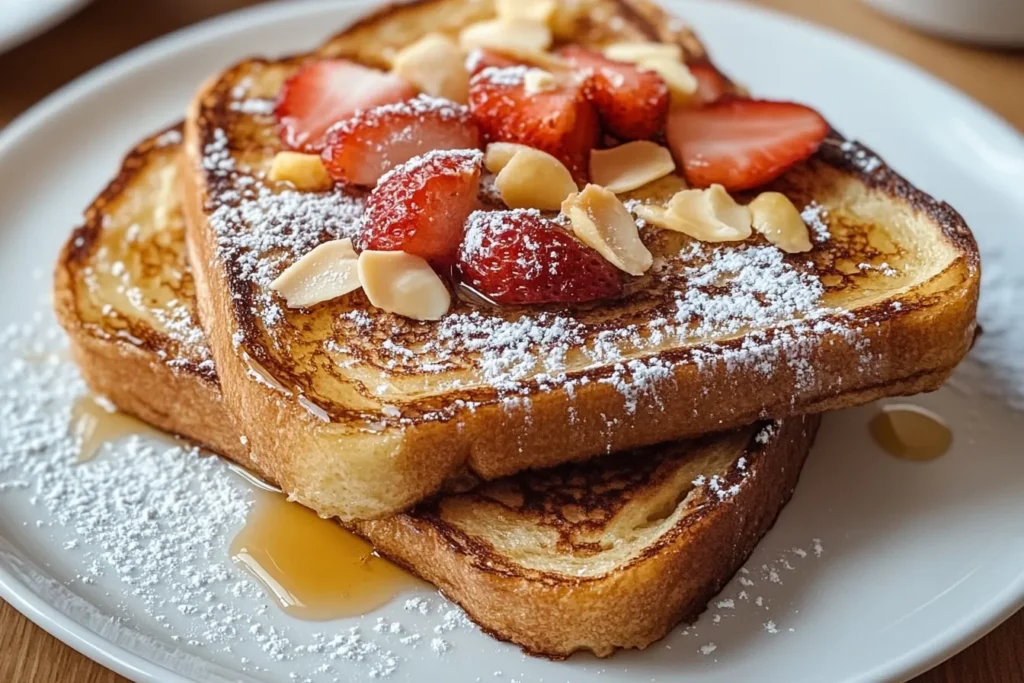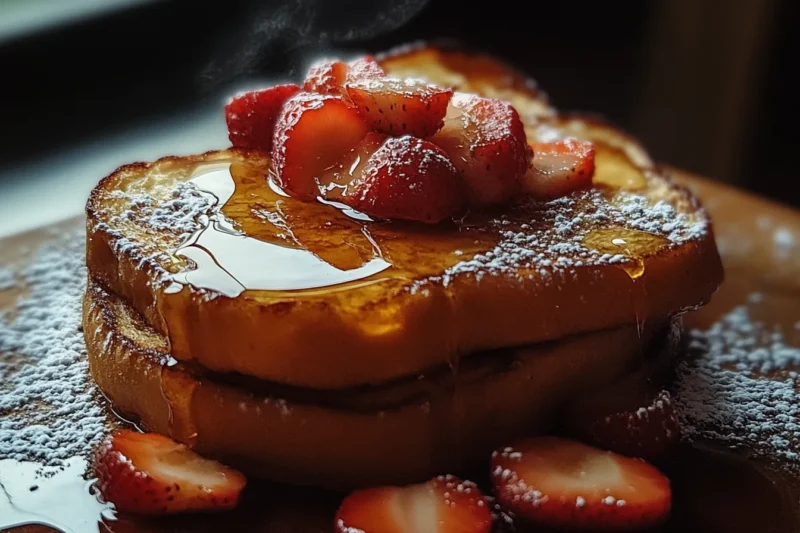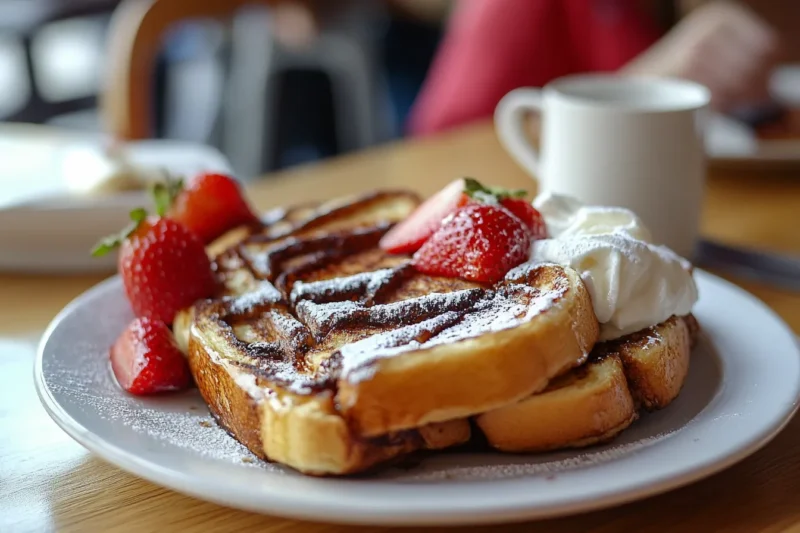What is the most common mistake in making French toast, making perfect French toast is a fun challenge. It needs careful attention and knowing the right techniques. From picking the right bread to mixing the custard and controlling the heat, small mistakes can ruin it. This guide will show you the common mistakes and how to avoid them, so your French toast turns out great.
Key Takeaways
- Understand the optimal bread-to-custard ratio for moist and fluffy French toast.
- Maintain the proper pan temperature throughout the cooking process.
- Master the art of soaking the bread to achieve even absorption of the custard.
- Choose the right type of bread for the desired texture and flavor profile.
- Craft the perfect custard mixture by balancing egg and milk proportions.
What is the Most Common Mistake in Making French Toast
Making perfect French toast is all about balance. Home cooks often mess up the bread-to-custard ratio, temperature, and soaking time. These mistakes can ruin the dish.
Understanding the Bread-to-Custard Ratio
The right bread-to-custard ratio is key for texture and taste. Too little custard makes the toast dry, while too much makes it soggy. Start with a 1:1 ratio to get it just right.
Common Temperature Control Issues
Temperature is crucial when cooking French toast. If the pan is too cold, the outside won’t brown and the inside won’t cook. Too hot, and the outside burns before the inside is done. Aim for a temperature of 350°F (175°C) for even cooking.
Timing Your Soaking Process
Soaking time is important for the toast’s texture. Soaking too little makes it dry, too long makes it soggy. Aim for 2-3 minutes per side to soak up the custard perfectly.
By avoiding these common mistakes, you can make French toast that’s crispy on the outside and soft on the inside. Every time (most common mistake)
Choosing the Wrong Type of Bread for French Toast
The type of bread you pick can change your French toast game. Many go for classic white sandwich bread. But, other options can make your breakfast even better. Let’s look at the top breads for French toast and why sourdough might be the missing piece.
It’s important for bread to soak up the custard well without getting too soggy. Breads like brioche or challah are great because they stay sturdy. But, soft, airy breads like white sandwich bread might turn mushy.(most common mistake)
What about sourdough bread for French toast? It brings a tangy twist to the classic. Sourdough soaks up the custard well and its flavor complements the sweetness. This makes for a delicious balance of tastes.
“Sourdough bread is a game-changer for French toast. The slight sourness and chewier texture add so much character to the dish.”
When picking the best bread for French toast, think about texture, density, and taste. Try different breads to find the one that makes your French toast amazing.
The Art of Creating the Perfect Custard Mixture
Making the perfect French toast custard is an art. It’s all about finding the right mix of egg-to-milk ratio and adding the best French toast seasonings. Let’s look at what makes a custard mixture that will change your French toast game.
Balancing Egg and Milk Proportions
The base of a creamy custard is the egg-to-milk mix. Use 3-4 eggs for every cup of milk. This mix makes the custard thick enough to cover the bread but still light. Try different mixes to find what you like best (most common mistake)
Selecting the Right Dairy Products
Whole milk is a classic pick, but mixing it with cream makes it richer. Cream’s fat adds to the custard’s thickness. Or, use plant-based milks like almond or oat for a dairy-free option.
Essential Seasonings and Flavorings
- Vanilla extract: Adds depth and complexity.
- Ground cinnamon: Brings warmth and comfort.
- Nutmeg: Adds a cozy, aromatic touch.
- Citrus zest: Balances the custard’s richness.
Try these and other seasonings to make a custard that’s just right for you. The goal is to find flavors that make your French toast even better(most common mistake)
“The secret to the best French toast is in the custard mixture. Get that right, and the rest will fall into place.”
Why Sourdough Bread Can Transform Your French Toast
Choosing the right bread can make your French toast amazing. While white or challah bread works, sourdough is a game-changer. Its unique taste and texture make it perfect for French toast.
Sourdough’s tangy flavor comes from fermentation. This process makes the bread denser and chewier. It soaks up the custard better, making the French toast crispy outside and soft inside. The sourdough’s complex flavors mix well with the custard’s sweetness, creating a perfect taste balance.
A Basic Sourdough French Toast Recipe
Want to try sourdough French toast? Here’s a simple recipe:
- 6 slices of sourdough bread
- 3 large eggs
- 1 cup of milk
- 1 teaspoon of vanilla extract
- 1/4 teaspoon of ground cinnamon
- Pinch of salt
- Butter or oil for cooking
In a shallow bowl, mix the eggs, milk, vanilla, cinnamon, and salt. Dip the sourdough slices in the custard, making sure they soak up the flavors on both sides.
Heat a skillet with butter or oil over medium heat. Cook the sourdough French toast for 2-3 minutes on each side. It should be golden brown and crispy. Serve it warm with maple syrup, fresh fruit, or powdered sugar (most common mistake)
Using sourdough bread in your French toast adds a new level of flavor and texture. It’s a great way to make your breakfast special. Try sourdough and see how it changes your French toast game.
Temperature Control: Getting the Pan Heat Just Right
Getting the French toast cooking temperature right is key for a golden-brown outside and a soft inside. It’s all about pan heat control. We’ll look at how to know your pan is ready and how to keep the heat steady.
Signs Your Pan is at the Ideal Temperature
When your pan is just right, you’ll see a few signs:
- The pan will shimmer or haze, showing it’s hot enough.
- A water drop on the pan will sizzle and disappear fast.
- The first French toast slice will sizzle and turn golden in 1-2 minutes.
If the pan is too cool, your French toast will soak up too much oil. If it’s too hot, the outside will burn before the inside is done (What is the most common mistake in making French toast).
Maintaining Consistent Heat Throughout Cooking
To cook French toast evenly, keep the pan heat steady. Here’s how:
- Start with medium-high heat and adjust as needed. Lower it if the toast browns too fast.
- Don’t overcrowd the pan. Cook slices in batches if you have to.
- Check the pan’s temperature often and adjust the heat to keep it steady.
- Use a heavy, well-seasoned pan to hold heat well(most common mistake).
Mastering French toast cooking temperature and pan heat control will help you make perfect French toast every time (What is the most common mistake in making French toast).
Proper Soaking Techniques for Even Absorption
Making perfect French toast begins with soaking your bread right. The secret to even custard absorption is in the soaking techniques. By mastering these, your French toast will be full of flavor and texture.
Many home cooks soak the bread too long, making it soggy. Soaking it too little can make it dry and uneven. The goal is to soak it just enough for the bread to absorb the custard without getting too wet.
Optimal Soaking Time and Technique
- Begin by cutting your bread into thick slices, about 1-inch thick. This helps the custard soak in better than thin slices.
- Make your custard mix with eggs, milk, and your favorite spices. Make sure the bread and custard mix are balanced.
- Put the bread slices in the custard, making sure they’re fully covered. Let them soak for 2-3 minutes on each side, until they’ve absorbed most of the liquid.
- Don’t let the bread soak too long, as it can become soggy. Watch closely and take out the slices when they start to get wet.
Different breads soak up custard at different rates. Thicker breads like sourdough might need a bit more time. Adjust your soaking time based on your bread type to get perfect French toast every time(most common mistake).
Mastering French toast soaking methods and bread absorption techniques will help you make amazing French toast. Try different soaking times and methods to find what works best for your bread and taste preferences.
The Battle of Breads: Brioche vs Sourdough for French Toast
Choosing the right bread is key to perfect French toast. Brioche and sourdough are two top picks, each with its own texture and taste. Let’s see how they compare and which one is better for French toast.
Texture Comparison Between Bread Types
Brioche is soft and buttery, making French toast feel luxurious. It has lots of egg and butter, so it soaks up custard well. Sourdough, on the other hand, is chewy and a bit crunchy. It adds a nice texture to French toast.
Flavor Profiles and Absorption Rates
Sourdough’s tangy taste goes well with sweet custard, creating a perfect balance. It absorbs custard slowly, so flavors stay even. Brioche, with its sweet and rich taste, makes French toast extra special.
Best Uses for Different Bread Varieties
- Brioche: Ideal for creating a luxurious, silky-smooth French toast with a rich, buttery flavor.
- Sourdough: Perfect for those seeking a more textural, tangy-sweet French toast with a satisfying bite( most common mistake).
Choosing between brioche and sourdough depends on what you like. Brioche offers a rich taste, while sourdough adds a tangy twist. Both make French toast delicious in their own way.
| Bread Type | Texture | Flavor Profile | Absorption Rate |
|---|---|---|---|
| Brioche | Soft, Pillowy | Rich, Buttery, Sweet | Rapid |
| Sourdough | Chewy, Slightly Crunchy | Tangy, Slightly Sour | Gradual |
“The right bread can make or break your French toast, so choose wisely!”
Essential Equipment and Tools for Perfect French Toast
Making perfect French toast needs more than just ingredients. You need the right tools and equipment for that golden brown outside and soft inside. Let’s look at the kitchen essentials that will elevate your French toast.
The Ideal Nonstick Pan
A good nonstick pan is key for French toast. Choose one with a smooth surface to prevent sticking and ensure even browning. Cast-iron or stainless steel pans also work, but you’ll need to grease them well (most common mistake).
Sturdy Spatula and Tongs
A sturdy, wide spatula is crucial for flipping French toast without breaking it. Use it with long-handled tongs for easy pan handling (most common mistake)
Shallow Baking Dish
A shallow baking dish or pie plate is ideal for dipping bread in custard. Its wide surface ensures even soaking of the bread (What is the most common mistake in making French toast).
Whisk and Measuring Tools
A quality whisk is essential for a smooth custard mix. Make sure you have measuring cups and spoons for the right custard ratio.
Serving Plates and Utensils
Don’t forget the finishing touches! Get sturdy serving plates and forks for a stylish presentation. A sprinkle of powdered sugar and warm maple syrup complete the dish.
With the right French toast cooking tools and French toast equipment, you’re ready to make unforgettable French toast (most common mistake).
Storage and Reheating Methods to Maintain Quality
Keeping French toast fresh is key, whether you have leftovers or want to make it ahead. The right storage and reheating methods can keep your French toast tasting great. It should stay as delicious as when it was first made.
Best Practices for Freezing French Toast
Freezing French toast is a great way to enjoy it for weeks. Here’s how to freeze it perfectly:
- Let the French toast cool down completely before freezing.
- Put the slices on a baking sheet or flat surface, making sure they don’t touch.
- Once frozen, put the slices in an airtight container or freezer bag. Try to remove as much air as you can.
- Write the date and what’s inside on the container. Then, store it in the freezer for 2-3 months.
Reheating Techniques for Optimal Results
When reheating frozen French toast, use these methods for the best taste:
- Oven Reheating: Preheat your oven to 350°F (175°C). Place the frozen French toast slices on a baking sheet. Bake for 8-10 minutes, flipping halfway, until crispy.
- Toaster or Toaster Oven: Put the frozen slices in the toaster or toaster oven. Toast until warmed and lightly crisped.
- Skillet Reheating: Heat a lightly oiled skillet over medium heat. Add the frozen French toast slices. Cook for 2-3 minutes per side, until heated through.
By using these storage and reheating tips, you can enjoy tasty French toast anytime. You won’t lose its amazing flavor and texture (What is the most common mistake in making French toast).
Conclusion
In this guide, we’ve covered common mistakes in making French toast. We’ve also shared key techniques for perfect results. Now, you know how to make your French toast better every time.
Whether you like brioche’s rich taste or sourdough’s tang, we’ve got you covered. Paying attention to the custard, soaking, and pan heat is crucial. This way, your French toast will be golden, fluffy, and full of flavor (most common mistake)
The secret to great French toast is in the details. Use these French toast tips summary and perfect French toast techniques for success. Get creative with your ingredients and enjoy the process of mastering this classic breakfast dish.
FAQ
Does sourdough taste good for French toast?
Yes, sourdough bread is great for French toast. Its tangy flavor and complex taste go well with the custard-like texture. The bread’s open crumb also helps it soak up the custard mixture evenly, making it delicious (most common mistake)
Does sourdough bread make good toast?
Yes, sourdough bread is perfect for toast. It’s sturdy and holds up well when toasted. Its unique flavor works well with both sweet and savory toppings. Toasted sourdough has a crunchy outside and a soft, chewy inside, making it great for French toast (most common mistake)
Is brioche or sourdough better for French toast?
Both brioche and sourdough can make tasty French toast. Brioche is rich and buttery, making the French toast more decadent. Sourdough, with its tangy flavor and chewy texture, offers a different experience. It comes down to what you prefer for your French toast.
What is the best sourdough French toast recipe?
Here’s a simple yet tasty sourdough French toast recipe: Ingredients: – 8 slices of sourdough bread – 4 large eggs – 1 cup of whole milk – 1/4 cup of heavy cream – 1 teaspoon of vanilla extract – 1/4 teaspoon of ground cinnamon – Pinch of salt Instructions: 1. Whisk the eggs, milk, heavy cream, vanilla, cinnamon, and salt in a shallow bowl. 2. Dip the sourdough bread slices into the custard mixture for 2-3 minutes per side. 3. Heat a large skillet or griddle over medium heat and grease it with butter or non-stick cooking spray. 4. Cook the soaked bread slices for 2-3 minutes per side, until golden brown and cooked through. 5. Serve the sourdough French toast warm, with your favorite toppings like maple syrup, fresh fruit, or powdered sugar.



